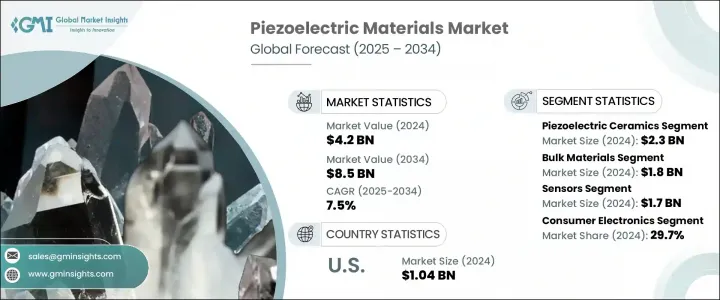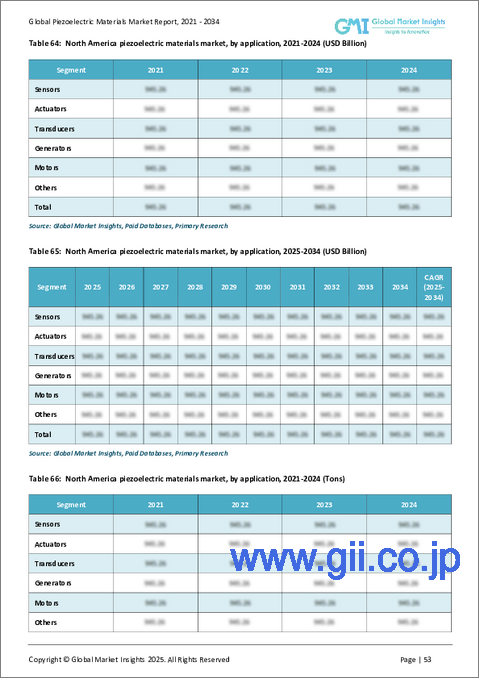|
|
市場調査レポート
商品コード
1782130
圧電材料の市場機会、成長促進要因、産業動向分析、2025~2034年予測Piezoelectric Materials Market Opportunity, Growth Drivers, Industry Trend Analysis, and Forecast 2025 - 2034 |
||||||
カスタマイズ可能
|
|||||||
| 圧電材料の市場機会、成長促進要因、産業動向分析、2025~2034年予測 |
|
出版日: 2025年07月02日
発行: Global Market Insights Inc.
ページ情報: 英文 235 Pages
納期: 2~3営業日
|
全表示
- 概要
- 目次
圧電材料の世界市場規模は、2024年に42億米ドルとなり、CAGR 7.5%で成長し、2034年には85億米ドルに達すると予測されています。
この急速な拡大は、主に幅広い産業分野におけるセンサーとアクチュエーターの需要の高まりによるものです。これらの材料は、圧力を検出し、振動を感知し、正確なモーションコントロールを提供する能力で高く評価されており、オートメーションやスマート製造環境において不可欠なものとなっています。高度な産業システムへの世界の後押しが続く中、高性能圧電ソリューションの使用はより一般的になり、操作の精度と効率が向上しています。

同時に、高感度で信頼性の高いコンポーネントの需要が高まっているヘルスケア技術での使用拡大も、この市場に利益をもたらしています。診断および手術機器における圧電対応システムの採用増加は、慢性疾患の増加や侵襲性の低い処置へのシフトと密接に結びついています。さらに、インテリジェントでインタラクティブなコンシューマエレクトロニクスのニーズが加速していることも、この市場の拡大に貢献しています。最新の機器に圧電部品を統合することで、フィードバック、タッチ感度、ジェスチャー制御が改善され、ユーザーエクスペリエンスが向上しています。さらに、エネルギーハーベスティングアプリケーションにおける技術革新が、圧電材料に新たなビジネスチャンスをもたらしています。
| 市場範囲 | |
|---|---|
| 開始年 | 2024 |
| 予測年 | 2025-2034 |
| 開始金額 | 42億米ドル |
| 予測金額 | 85億米ドル |
| CAGR | 7.5% |
2024年、圧電セラミック分野は23億米ドルを生み出し、2025年から2034年までCAGR 6.7%で成長すると予測されています。これらのセラミックスは、その汎用性、高い機械的強度、重要な用途における強力な性能により、最大の市場シェアを占めています。長期的な信頼性とコスト効率の高さから、産業・技術分野のさまざまな機器に好んで使用されています。特に、耐久性があり正確な圧電機能を必要とするシステムでは、その幅広い適用性がこのセグメントの成長を後押しし続けています。
センサー分野は2024年に17億米ドルを生み出し、2025年から2034年にかけてCAGR 7%で成長すると推定されています。消費者技術、輸送、医療診断の分野で精密で応答性の高いソリューションへの需要が高まっていることが背景にあります。圧電材料固有の応答性を活用する能力により、高精度電子システムの礎石となり、広範な産業で機能性を高めています。
米国の圧電材料市場は2024年に10億4,000万米ドルとなり、2034年までCAGR 7.2%で成長すると予測されています。米国は、防衛、医療機器、エレクトロニクスなどの重要分野における持続的な需要に後押しされ、力強い成長を続けています。業界大手の確固たる存在感と次世代センシング技術の迅速な導入に支えられた研究開発活動の強力なエコシステムが、米国市場に競争力を与え続けています。コンパクトでウェアラブルな技術ソリューションへの関心の高まりも、国内でのこれらの材料の使用を加速させています。
TDK株式会社、CTS株式会社、京セラ株式会社、APC International Ltd.、株式会社村田製作所など、圧電材料世界市場の主要企業は、さまざまな戦略分野で激しい競争を繰り広げています。より強固な市場ポジショニングを確保するため、圧電材料分野の主要企業は、将来を見据えた様々な戦略を展開しています。
製品性能の向上、小型化、次世代システムへの統合に重点を置き、研究開発への多額の投資は引き続き中心的な役割を担っています。OEMとの戦略的パートナーシップやコラボレーションは、顧客開拓と技術能力の拡大に役立っています。企業はまた、エネルギーハーベスティングや先端医療技術のようなニッチ分野に対応するために製品ポートフォリオを多様化する一方で、増大する需要に対応するために世界な製造とサプライチェーンのインフラを拡大しています。こうしたアプローチは、競争上の優位性を維持し、長期的な成長を確保するために不可欠です。
目次
第1章 調査手法
- 市場の範囲と定義
- 調査デザイン
- 調査アプローチ
- データ収集方法
- データマイニングソース
- 世界
- 地域/国
- 基本推定と計算
- 基準年計算
- 市場予測の主な動向
- 1次調査と検証
- 一次情報
- 予測モデル
- 調査の前提と限界
第2章 エグゼクティブサマリー
第3章 業界考察
- エコシステム分析
- サプライヤーの情勢
- 利益率
- 各段階での付加価値
- バリューチェーンに影響を与える要因
- ディスラプション
- 業界への影響要因
- 促進要因
- 業界の潜在的リスク&課題
- 市場機会
- 成長可能性分析
- 規制情勢
- 北米
- 欧州
- アジア太平洋地域
- ラテンアメリカ
- 中東・アフリカ
- ポーターの分析
- PESTEL分析
- 価格動向
- 地域別
- 製品別
- 将来の市場動向
- テクノロジーとイノベーションの情勢
- 現在の技術動向
- 新興技術
- 特許情勢
- 貿易統計(HSコード)注:貿易統計は主要国のみ提供されます
- 主要輸入国
- 主要輸出国
- 持続可能性と環境側面
- 持続可能な慣行
- 廃棄物削減戦略
- 生産におけるエネルギー効率
- 環境に優しい取り組み
- カーボンフットプリントの考慮
第4章 競合情勢
- イントロダクション
- 企業の市場シェア分析
- 地域別
- 北米
- 欧州
- アジア太平洋地域
- ラテンアメリカ航空
- 中東・アフリカ
- 地域別
- 企業マトリックス分析
- 主要市場企業の競合分析
- 競合ポジショニングマトリックス
- 主な発展
- 合併と買収
- パートナーシップとコラボレーション
- 新製品の発売
- 拡張計画
第5章 市場推計・予測:材料別、2021年~2034年
- 主要動向
- 圧電セラミックス
- チタン酸ジルコン酸鉛(PZT)
- チタン酸バリウム(BaTiO3)
- ニオブ酸ナトリウムカリウム(KNN)
- チタン酸ビスマスナトリウム(NBT)
- その他の圧電セラミックス
- 圧電ポリマー
- ポリフッ化ビニリデン(PVDF)
- PVDFコポリマー
- その他の圧電ポリマー
- 圧電複合材料
- セラミックポリマー複合材料
- セラミック-セラミック複合材料
- その他の圧電複合材料
- 圧電単結晶
- 石英
- リラクサーPT単結晶
- その他の圧電単結晶
- その他の圧電材料
第6章 市場推計・予測:形態別、2021年~2034年
- 主要動向
- バルク材料
- 薄膜
- ナノ構造
- 多層構造
- その他
第7章 市場推計・予測:用途別、2021年~2034年
- 主要動向
- センサー
- 圧力センサー
- 加速度計
- 力センサー
- その他のセンサー
- アクチュエータ
- 精密ポジショナー
- 超音波モーター
- 圧電ポンプ
- その他のアクチュエータ
- トランスデューサー
- 超音波トランスデューサー
- 音響トランスデューサー
- その他のトランスデューサー
- 発電機
- エネルギーハーベスター
- 点火システム
- その他の発電機
- モーター
- その他
第8章 市場推計・予測:最終用途産業別、2021年~2034年
- 主要動向
- 家電
- スマートフォンとタブレット
- ウェアラブルデバイス
- その他の家電製品
- ヘルスケア
- 医療画像
- 外科用機器
- 埋め込み型デバイス
- その他のヘルスケア用途
- 自動車
- 燃料噴射システム
- エンジン管理システム
- タイヤ空気圧監視システム
- その他の自動車用途
- 産業
- プロセス制御
- 非破壊検査
- 精密加工
- その他の産業用途
- 航空宇宙および防衛
- 構造健全性モニタリング
- ソナーシステム
- その他の航空宇宙および防衛用途
- エネルギーハーベスティング
- その他
第9章 市場推計・予測:地域別、2021年~2034年
- 主要動向
- 北米
- 米国
- カナダ
- 欧州
- ドイツ
- 英国
- フランス
- スペイン
- イタリア
- その他欧州地域
- アジア太平洋地域
- 中国
- インド
- 日本
- オーストラリア
- 韓国
- その他アジア太平洋地域
- ラテンアメリカ
- ブラジル
- メキシコ
- アルゼンチン
- その他ラテンアメリカ地域
- 中東・アフリカ
- サウジアラビア
- 南アフリカ
- アラブ首長国連邦
- その他中東・アフリカ地域
第10章 企業プロファイル
- Murata Manufacturing Co., Ltd.
- TDK Corporation
- Kyocera Corporation
- CTS Corporation
- PI Ceramic GmbH
- Morgan Advanced Materials
- Physik Instrumente(PI)GmbH &Co. KG
- APC International, Ltd.
- Piezosystem Jena GmbH
- Piezo Technologies
- Exelis Inc.(Harris Corporation)
- Piezo Kinetics Inc.
- Meggitt PLC
- Piezo Solutions
- Smart Material Corp.
- Solvay S.A.
- Arkema Group
- Piezocryst Advanced Sensorics GmbH
- Channel Technologies Group
- Kistler Group
The Global Piezoelectric Materials Market was valued at USD 4.2 billion in 2024 and is estimated to grow at a CAGR of 7.5% to reach USD 8.5 billion by 2034. This rapid expansion is mainly driven by the rising demand for sensors and actuators across a wide spectrum of industries. These materials are highly valued for their ability to detect pressure, sense vibration, and provide accurate motion control, making them indispensable in automation and smart manufacturing environments. As the global push toward advanced industrial systems continues, the use of high-performance piezoelectric solutions is becoming more common, enhancing operational precision and efficiency.

Simultaneously, the market is benefiting from expanding usage in healthcare technologies, where demand for high-sensitivity, reliable components is on the rise. Increasing adoption of piezoelectric-enabled systems in diagnostics and surgical equipment is tied closely to the growth in chronic illnesses and a shift toward less invasive procedures. Moreover, the accelerating need for intelligent and interactive consumer electronics is helping expand this market. Integration of piezoelectric components into modern devices is enhancing user experience with improved feedback, touch sensitivity, and gesture control. Additionally, innovation in energy harvesting applications is opening new channels of opportunity for piezoelectric materials.
| Market Scope | |
|---|---|
| Start Year | 2024 |
| Forecast Year | 2025-2034 |
| Start Value | $4.2 Billion |
| Forecast Value | $8.5 Billion |
| CAGR | 7.5% |
In 2024, the piezoelectric ceramics segment generated USD 2.3 billion and is projected to grow at a 6.7% CAGR from 2025 to 2034. These ceramics hold the largest market share due to their versatility, high mechanical strength, and strong performance in critical applications. Their long-term reliability and cost-efficiency make them the preferred choice for use in a range of equipment across industrial and technological sectors. Their wide applicability continues to push this segment's growth, especially in systems requiring durable and accurate piezoelectric functions.
The sensors segment generated USD 1.7 billion in 2024 and is estimated to grow at a CAGR of 7% from 2025 to 2034. The sensors category holds the top position in terms of market contribution, driven by increasing demand for precise and responsive solutions in the fields of consumer tech, transportation, and medical diagnostics. Their ability to leverage the inherent responsiveness of piezoelectric materials makes them a cornerstone in high-precision electronic systems, enhancing functionality in a broad array of industries.
United States Piezoelectric Materials Market was valued at USD 1.04 billion in 2024 and is projected to grow at a 7.2% CAGR through 2034. The U.S. continues to show strong growth, fueled by sustained demand in critical sectors such as defense, medical equipment, and electronics. A strong ecosystem of R&D activity, supported by a solid presence of major industry players and the swift adoption of next generation sensing technologies, continues to give the U.S. market a competitive edge. The rising interest in compact and wearable tech solutions is also accelerating the use of these materials domestically.
Key players in the Global Piezoelectric Materials Market, including TDK Corporation, CTS Corporation, Kyocera Corporation, APC International Ltd., and Murata Manufacturing Co., Ltd., are locked in fierce competition across various strategic areas. To secure stronger market positioning, leading companies in the piezoelectric materials sector are deploying a mix of forward-looking strategies.
Significant investment in research and development remains central, with a focus on boosting product performance, miniaturization, and integration into next-gen systems. Strategic partnerships and collaborations with OEMs help expand customer reach and technical capability. Firms are also scaling up their global manufacturing and supply chain infrastructure to meet growing demand, while diversifying their product portfolios to address niche segments like energy harvesting and advanced medical technologies. These approaches are essential in maintaining competitive advantage and ensuring long-term growth.
Table of Contents
Chapter 1 Methodology
- 1.1 Market scope and definition
- 1.2 Research design
- 1.2.1 Research approach
- 1.2.2 Data collection methods
- 1.3 Data mining sources
- 1.3.1 Global
- 1.3.2 Regional/Country
- 1.4 Base estimates and calculations
- 1.4.1 Base year calculation
- 1.4.2 Key trends for market estimation
- 1.5 Primary research and validation
- 1.5.1 Primary sources
- 1.6 Forecast model
- 1.7 Research assumptions and limitations
Chapter 2 Executive Summary
- 2.1 Industry 3600 synopsis
- 2.2 Key market trends
- 2.2.1 Regional
- 2.3 TAM Analysis, 2025-2034
- 2.4 CXO perspectives: Strategic imperatives
- 2.4.1 Executive decision points
- 2.4.2 Critical success factors
- 2.5 Future Outlook and Strategic Recommendations
Chapter 3 Industry Insights
- 3.1 Industry ecosystem analysis
- 3.1.1 Supplier Landscape
- 3.1.2 Profit Margin
- 3.1.3 Value addition at each stage
- 3.1.4 Factor affecting the value chain
- 3.1.5 Disruptions
- 3.2 Industry impact forces
- 3.2.1 Growth drivers
- 3.2.2 Industry pitfalls and challenges
- 3.2.3 Market opportunities
- 3.3 Growth potential analysis
- 3.4 Regulatory landscape
- 3.4.1 North America
- 3.4.2 Europe
- 3.4.3 Asia Pacific
- 3.4.4 Latin America
- 3.4.5 Middle East & Africa
- 3.5 Porter’s analysis
- 3.6 PESTEL analysis
- 3.6.1 Technology and Innovation landscape
- 3.6.2 Current technological trends
- 3.6.3 Emerging technologies
- 3.7 Price trends
- 3.7.1 By region
- 3.7.2 By product
- 3.8 Future market trends
- 3.9 Technology and Innovation landscape
- 3.9.1 Current technological trends
- 3.9.2 Emerging technologies
- 3.10 Patent Landscape
- 3.11 Trade statistics (HS code) Note: the trade statistics will be provided for key countries only
- 3.11.1 Major importing countries
- 3.11.2 Major exporting countries
- 3.12 Sustainability and Environmental Aspects
- 3.12.1 Sustainable practices
- 3.12.2 Waste Reduction strategies
- 3.12.3 Energy Efficiency in production
- 3.12.4 Eco-friendly initiatives
- 3.13 Carbon footprint considerations
Chapter 4 Competitive Landscape, 2024
- 4.1 Introduction
- 4.2 Company market share analysis
- 4.2.1 By region
- 4.2.1.1 North America
- 4.2.1.2 Europe
- 4.2.1.3 Asia Pacific
- 4.2.1.4 LATAM
- 4.2.1.5 MEA
- 4.2.1 By region
- 4.3 Company matrix analysis
- 4.4 Competitive analysis of major market players
- 4.5 Competitive positioning matrix
- 4.6 Key developments
- 4.6.1 Mergers & acquisitions
- 4.6.2 Partnerships & collaborations
- 4.6.3 New Product Launches
- 4.6.4 Expansion Plans
Chapter 5 Market Estimates and Forecast, By Material Type, 2021 - 2034 (USD Billion) (Kilo Tons)
- 5.1 Key trends
- 5.2 Piezoelectric ceramics
- 5.2.1 Lead zirconate titanate (PZT)
- 5.2.2 Barium titanate (BaTiO3)
- 5.2.3 Sodium potassium niobate (KNN)
- 5.2.4 Sodium bismuth titanate (NBT)
- 5.2.5 Other piezoelectric ceramics
- 5.3 Piezoelectric polymers
- 5.3.1 Polyvinylidene fluoride (PVDF)
- 5.3.2 PVDF copolymers
- 5.3.3 Other piezoelectric polymers
- 5.4 Piezoelectric composites
- 5.4.1 Ceramic-polymer composites
- 5.4.2 Ceramic-ceramic composites
- 5.4.3 Other piezoelectric composites
- 5.5 Piezoelectric single crystals
- 5.5.1 Quartz
- 5.5.2 Relaxor-PT single crystals
- 5.5.3 Other piezoelectric single crystals
- 5.6 Other piezoelectric materials
Chapter 6 Market Estimates and Forecast, By Forms, 2021 - 2034 (USD Billion) (Kilo Tons)
- 6.1 Key trends
- 6.2 Bulk materials
- 6.3 Thin films
- 6.4 Nanostructures
- 6.5 Multilayer structures
- 6.6 Others
Chapter 7 Market Estimates and Forecast, By Application, 2021 - 2034 (USD Billion) (Kilo Tons)
- 7.1 Key trends
- 7.2 Sensors
- 7.2.1 Pressure sensors
- 7.2.2 Accelerometers
- 7.2.3 Force sensors
- 7.2.4 Other sensors
- 7.3 Actuators
- 7.3.1 Precision positioners
- 7.3.2 Ultrasonic motors
- 7.3.3 Piezoelectric pumps
- 7.3.4 Other actuators
- 7.4 Transducers
- 7.4.1 Ultrasonic transducers
- 7.4.2 Acoustic transducers
- 7.4.3 Other transducers
- 7.5 Generators
- 7.5.1 Energy harvesters
- 7.5.2 Ignition systems
- 7.5.3 Other generators
- 7.6 Motors
- 7.7 Others
Chapter 8 Market Estimates and Forecast, By End-Use Industry, 2021 - 2034 (USD Billion) (Kilo Tons)
- 8.1 Key trends
- 8.2 Consumer electronics
- 8.2.1 Smartphones and tablets
- 8.2.2 Wearable devices
- 8.2.3 Other consumer electronics
- 8.3 Healthcare
- 8.3.1 Medical imaging
- 8.3.2 Surgical devices
- 8.3.3 Implantable devices
- 8.3.4 Other healthcare applications
- 8.4 Automotive
- 8.4.1 Fuel injection systems
- 8.4.2 Engine management systems
- 8.4.3 Tire pressure monitoring systems
- 8.4.4 Other automotive applications
- 8.5 Industrial
- 8.5.1 Process control
- 8.5.2 Non-destructive testing
- 8.5.3 Precision machining
- 8.5.4 Other industrial applications
- 8.6 Aerospace & defense
- 8.6.1 Structural health monitoring
- 8.6.2 Sonar systems
- 8.6.3 Other aerospace & defense applications
- 8.7 Energy harvesting
- 8.8 Others
Chapter 9 Market Estimates and Forecast, By Region, 2021 - 2034 (USD Billion) (Kilo Tons)
- 9.1 Key trends
- 9.2 North America
- 9.2.1 U.S.
- 9.2.2 Canada
- 9.3 Europe
- 9.3.1 Germany
- 9.3.2 UK
- 9.3.3 France
- 9.3.4 Spain
- 9.3.5 Italy
- 9.3.6 Rest of Europe
- 9.4 Asia Pacific
- 9.4.1 China
- 9.4.2 India
- 9.4.3 Japan
- 9.4.4 Australia
- 9.4.5 South Korea
- 9.4.6 Rest of Asia Pacific
- 9.5 Latin America
- 9.5.1 Brazil
- 9.5.2 Mexico
- 9.5.3 Argentina
- 9.5.4 Rest of Latin America
- 9.6 Middle East and Africa
- 9.6.1 Saudi Arabia
- 9.6.2 South Africa
- 9.6.3 UAE
- 9.6.4 Rest of Middle East and Africa
Chapter 10 Company Profiles
- 10.1 Murata Manufacturing Co., Ltd.
- 10.2 TDK Corporation
- 10.3 Kyocera Corporation
- 10.4 CTS Corporation
- 10.5 PI Ceramic GmbH
- 10.6 Morgan Advanced Materials
- 10.7 Physik Instrumente (PI) GmbH & Co. KG
- 10.8 APC International, Ltd.
- 10.9 Piezosystem Jena GmbH
- 10.10 Piezo Technologies
- 10.11 Exelis Inc. (Harris Corporation)
- 10.12 Piezo Kinetics Inc.
- 10.13 Meggitt PLC
- 10.14 Piezo Solutions
- 10.15 Smart Material Corp.
- 10.16 Solvay S.A.
- 10.17 Arkema Group
- 10.18 Piezocryst Advanced Sensorics GmbH
- 10.19 Channel Technologies Group
- 10.20 Kistler Group






